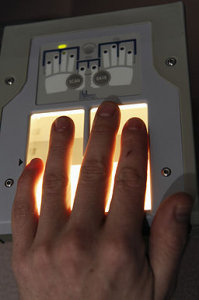Imagine finally landing in another country after a 15-hour flight and being held up at immigration because the government-run Global Entry fingerprint scanner can’t read your fingerprints.
For many travelers, this inconvenience happens all too often. Fortunately, thanks to a new generation of fingerprint readers, you won’t have to press your finger to an oily patch of skin and try again (what many travelers attest is the way to get a scanner to read your fingerprints).
Critics of the Global Entry program have argued for years that machines’ inability to pick up every passenger’s finger prints can cause delays and even missed flights. Experts estimate that anywhere from 1 to 4% of the travelers have fingerprints that are too light to be read by machines. Faint fingerprints are not always the problem, though. The scanners themselves can be temperamental—the finger has to be laid flat, in a certain position, with a specific amount of pressure for the print to be read.
Cross Match Technologies, a Florida-based manufacturer of scanning equipment, is producing a more user-friendly machine that will detect fingerprints more easily.
Global Entry isa program set up by the government that enables members to pass directly through immigration without waiting to be seen at a kiosk. Members scan their passport and their fingerprints and proceed directly to the flight gate.
The new and improved finger print readers are expected to reduce instances of failure because they are able to take fingerprints regardless of if they are wet or dry. Furthermore, they will also provide users with more specific instructions, such as indications to “press harder” on the keypad.
Global Entry is also looking into using other biometric data to back up fingerprints, such as iris and facial recognition technology. However, it will be a while before this new biometric system is able to be used. For now, users with faint fingerprints will have to wait for the new machines to arrive.

